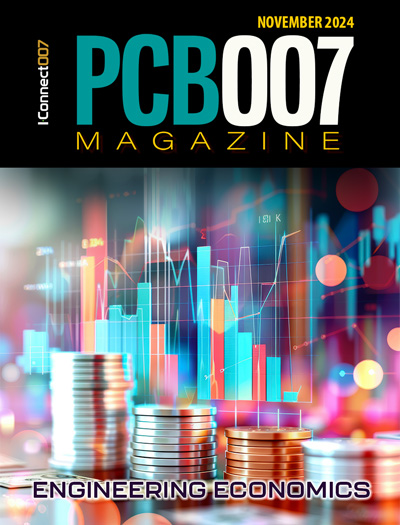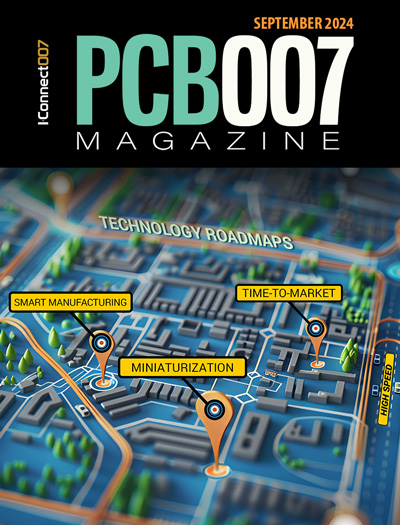-

- News
- Books
Featured Books
- pcb007 Magazine
Latest Issues
Current Issue
Engineering Economics
The real cost to manufacture a PCB encompasses everything that goes into making the product: the materials and other value-added supplies, machine and personnel costs, and most importantly, your quality. A hard look at real costs seems wholly appropriate.

Alternate Metallization Processes
Traditional electroless copper and electroless copper immersion gold have been primary PCB plating methods for decades. But alternative plating metals and processes have been introduced over the past few years as miniaturization and advanced packaging continue to develop.

Technology Roadmaps
In this issue of PCB007 Magazine, we discuss technology roadmaps and what they mean for our businesses, providing context to the all-important question: What is my company’s technology roadmap?
- Articles
- Columns
Search Console
- Links
- Media kit
||| MENU - pcb007 Magazine
Panasonic Develops Ultra-Low-Loss PCB Material for Packages and Modules
May 29, 2018 | Panasonic CorporationEstimated reading time: Less than a minute
Panasonic Corporation has developed an ultra-low transmission loss circuit board material (Product No. Laminate R-G545L/R-G545E, Prepreg R-G540L/R-G540E) that is suitable for use in semiconductor packages and modules. The company will start mass-producing the material from June 2018. The newly developed material allows the stable operation of semiconductor devices that process enormous data at a high speed.
Due to the expansion of IoT (Internet of Things) network and the launch of the fifth-generation (5G) mobile communications system scheduled to be implemented in 2020. It is expected that the data communication will become further larger in volume and faster.
This circumstance has created a demand for circuit board materials used in semiconductor packages and modules that need to be adapted for high-speed/large-capacity data communication applications. From its original resin design technology, the company has developed the circuit board material with ultra-low transmission loss for semiconductor packages and modules. The material offers the lowest transmission loss among the other materials used in the industry.
For more information, click here.
Suggested Items
Trouble in Your Tank: Materials for PWB Fabrication—Drillability and Metallization
07/16/2024 | Michael Carano -- Column: Trouble in Your TankLaminate materials are the building blocks on which printed circuit boards are manufactured. Circuit board designers rely on the critical electrical properties of the materials to design the interconnects, and with the drive toward IoT (internet of things), autonomous driving, and virtual and augmented reality, material properties take on a very high level of importance.
Don’t Overconstrain Your Board Materials
07/02/2024 | I-Connect007 Editorial TeamWhen we started planning May’s issue, which centers on the use of traditional laminates in certain high-frequency PCBs, we knew we had to interview Kris Moyer and Ed Kelley together. Kris teaches advanced PCB design classes for IPC, and Ed is the former CTO of Isola and founder of Four Peaks Innovation. What ensued was a wide-ranging discussion on the evolution of “standard” PCB laminates and the recent trend by some OEMs to use these materials in high-frequency and even RF boards.
Underconstraining Your Materials? Leave It to the Experts
05/30/2024 | I-Connect007 Editorial TeamWith traditional laminates now sporting improved resin systems, some OEMs are choosing various flavors of FR-4 instead of high-speed laminates for their high-speed designs—even RF applications. Avoiding overconstraining your materials in high-speed products can lead to considerable cost savings, not to mention a more streamlined trip through fabrication.
The Shaughnessy Report: Unlock Your High-speed Material Constraints
05/15/2024 | Andy Shaughnessy -- Column: The Shaughnessy ReportThe world of PCB materials used to be a fairly simple one. It was divided into two groups: the “traditional” laminates, often called FR-4, and the high-speed laminates developed especially for high-speed PCBs. These were two worlds that usually didn’t collide. But then traditional laminates started getting better, and high-speed designers and design engineers took notice and started to reconsider what FR-4 could be used for.
Breaking High-speed Material Constraints: Design007 Magazine — May 2024
05/14/2024 | I-Connect007 Editorial TeamDo you need specialty materials for your high-speed designs? Maybe not. Improvements in resins mean designers of high-speed boards can sometimes use traditional laminate systems instead of high-speed materials, saving time and money while streamlining the fab process. In the May 2024 issue of Design007 Magazine, our contributors explain how to avoid overconstraining your materials when working with high-speed boards.


